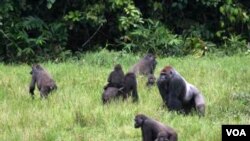A region in Central Africa with some of the last great populations of forest elephants, gorillas and chimpanzees has been declared a U.N. World Heritage Site. It consists of about 25,000 square kilometers spanning the Republic of Congo, Cameroon and Central African Republic.
It’s called the Sangha Tri-National Protected Area complex, also known by the French acronym TNS. It’s formed by three contiguous national parks that are linked by the Sangha River.
Wild Heart
James Deutsch, director of the Wildlife Conservation Society’s Africa Program, calls the World Heritage Site the “wild heart of the Congo Basin Rainforest.”
“The Sangha Tri-National is one of only two or three areas left in the Congo Basin Rainforest that is physically intact in terms of both the forest cover and the trees. But more importantly also still has all of the wildlife populations, all of the different species for which the Congo Basin is so well known – elephants and gorillas and chimpanzees. And by many measures this area is really the most intact remaining large expanse of rainforest in Africa,” he said.
The Congo Basin is the world’s second largest rainforest after the Amazon.
Deutsch said that giving the TNS World Heritage Site status does several things.
“Probably most importantly, it commits the three countries – Cameroon, Congo-Brazzaville and the Central African Republic – to cherishing this area and helping to protect it in perpetuity. For any country, as that country faces the various trade-offs between industrial development and conservation, that kind of commitment is hugely important,” he said.
Poachers, loggers and HIV
But despite being a protected area consisting of national parks and now a World Heritage Site, the complex still faces threats.
Deutsch said, “Probably the most urgent threat that has really accelerated in the last few years has been elephant poaching because of an increase in demand for ivory in Asia and an increase in organized crime’s involvement in elephant poaching and ivory trafficking.”
Another major challenge facing the TNS is balancing conservation with the demand for commercial logging.
“The big problem with logging, with selective logging in particular, is that it opens up access to the forest to people to go in and remove the wildlife species,” he said.
However, when people go into places where humans do not normally tread, diseases can come out and affect the entire world.
“This exact area is, according to experts, the area where HIV made the jump from chimpanzees to humans sometime around a hundred years ago, probably as a result of people hunting chimps. It’s also very near the focal area for the Ebola virus, which of course is hugely harmful to people, in fact lethal in 70, 80 percent of cases. And we don’t know what other pathogens, what other viruses and other potential diseases lurk in the forest and in the wildlife in the forest,” he said.
Deutsch says achieving World Heritage Site status for the Tri-National Protected Area complex took many years of hard work by the three countries, various governments and many groups and individuals. He adds it means the TNS is a world treasure.
It’s called the Sangha Tri-National Protected Area complex, also known by the French acronym TNS. It’s formed by three contiguous national parks that are linked by the Sangha River.
Wild Heart
James Deutsch, director of the Wildlife Conservation Society’s Africa Program, calls the World Heritage Site the “wild heart of the Congo Basin Rainforest.”
“The Sangha Tri-National is one of only two or three areas left in the Congo Basin Rainforest that is physically intact in terms of both the forest cover and the trees. But more importantly also still has all of the wildlife populations, all of the different species for which the Congo Basin is so well known – elephants and gorillas and chimpanzees. And by many measures this area is really the most intact remaining large expanse of rainforest in Africa,” he said.
The Congo Basin is the world’s second largest rainforest after the Amazon.
Deutsch said that giving the TNS World Heritage Site status does several things.
“Probably most importantly, it commits the three countries – Cameroon, Congo-Brazzaville and the Central African Republic – to cherishing this area and helping to protect it in perpetuity. For any country, as that country faces the various trade-offs between industrial development and conservation, that kind of commitment is hugely important,” he said.
Poachers, loggers and HIV
But despite being a protected area consisting of national parks and now a World Heritage Site, the complex still faces threats.
Deutsch said, “Probably the most urgent threat that has really accelerated in the last few years has been elephant poaching because of an increase in demand for ivory in Asia and an increase in organized crime’s involvement in elephant poaching and ivory trafficking.”
Another major challenge facing the TNS is balancing conservation with the demand for commercial logging.
“The big problem with logging, with selective logging in particular, is that it opens up access to the forest to people to go in and remove the wildlife species,” he said.
However, when people go into places where humans do not normally tread, diseases can come out and affect the entire world.
“This exact area is, according to experts, the area where HIV made the jump from chimpanzees to humans sometime around a hundred years ago, probably as a result of people hunting chimps. It’s also very near the focal area for the Ebola virus, which of course is hugely harmful to people, in fact lethal in 70, 80 percent of cases. And we don’t know what other pathogens, what other viruses and other potential diseases lurk in the forest and in the wildlife in the forest,” he said.
Deutsch says achieving World Heritage Site status for the Tri-National Protected Area complex took many years of hard work by the three countries, various governments and many groups and individuals. He adds it means the TNS is a world treasure.









